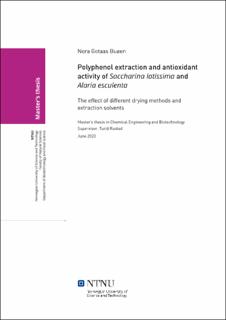Polyphenol extraction and antioxidant activity of Saccharina latissima and Alaria esculenta
Master thesis
Permanent lenke
https://hdl.handle.net/11250/2782561Utgivelsesdato
2020Metadata
Vis full innførselSamlinger
Sammendrag
Interessen for dyrking, produksjon og utnyttelse av tang og tare har økt det siste tiaret i den vestlige verden. Den raske befolkningsveksten i verden gjør at etterspørselen ettermat, for og drivstoff øker, og det er derfor viktig å utnytte de ressursene som sjø og land kan gi, som ikke utnyttes til det fulle i dag, for eksempel biomasse fra tang og tare. Tanginneholder en rekke verdifulle forbindelser og komponenter som kan brukes som mat,for, funksjonelle ingredienser, gjødsel osv. I tillegg har forbindelsene og komponentenei tang viktige biologiske aktiviteter som kan forbedre menneskers helse og kan forhindreforskjellige sykdommer.I dette studiet har fem forskjellige screeningmetoder blitt utført for a måle potensiell antioksidantaktivitet av frysetørket, ovnstørket og våt Saccharina latissima og Alaria esculenta, ekstrahert i vann, 70% aceton og 70% etanol. Det ble observert signifikante forskjeller mellom behandlingsmetoder, ekstraksjonsløsemidler og de to makroalgene.
De fem forskjellige screeningmetodene som ble brukt i denne studien var Folin-Ciocalteuanalysen som ble brukt for a måle det totale fenolinnholdet (TPC) i makroalgene. Det bleutført to metoder som måler inhibering av frie radikale, DPPH (2,2-diphenyl-1-picrylhydrazyl)-analyse og ABTS (2,2’-azino-bis(3-ethylbenzothiazoline-6-sulphonic acid))-analyse.En jernbindingsevne analyse ble utført og denne maler forbindelsene i tang sin evne til åbinde seg til overgangsmetaller, og sist ferric reducing antioxsidant power, FRAP-analyse,som måler reduksjonsevnen til komponentene ekstrahert fra tang.
Resultatene av totalt fenolinnhold og antioksidantaktiviteten demonstrerte at frysetørkingbevarer fenolforbindelser og utviser en høyere antioksidantaktivitet sammenlignet medovntørking, bortsett fra ved jernbindingsevne analysen. De vate prøvene viste signifikante forskjeller mellom A. esculenta og S. latissima som indikerer at A. esculenta er en høyfenoliskart og har bedre antioksidantpotensial. Korrelasjoner ble funnet mellom totalt fenolinnholdog de to metodene som maler inhibering av frie radikaler (DPPH og ABTS), noe som indikerer at polyfenoler bidrar til antioksidantaktiviteten i tang. Imidlertid ble det ikke funnet korrelasjoner mellom totalt fenolinnhold og jernbindingsevne, og ferric reducing antixoidant power, som betyr at andre forbindelser ogsa kan bidra til antioksidantaktiviteten. The interest in cultivation, production and utilization of seaweeds has increased over the last decade in the Western World. The rapid population growth in the world increases the demand for food, feed and fuel, and it is therefore important to utilize the un-exploited resources the sea and land can provide, such as seaweed biomass. Seaweeds contain a variety of valuable compounds and components which can be used as food, feed, functional ingredients and fertilizers etc. Moreover, the compounds and components in seaweeds possess important biological activities that benefits human health and may prevent different diseases. In the present study, five different screening methods for measuring potential antioxidant activity of freeze-dried, oven-dried and wet Saccharina latissima and Alaria esculenta, extracted in water, 70% acetone and 70% ethanol were performed. Significant differences between pre-treatment methods, extraction solvents and the two macroalgae were observed.
The five different screening methods used in the present study were; the Folin-Ciocalteu assay, which measures the total phenolic content (TPC) in the macroalgae. Two free radical scavenging assays were performed, 2,2-diphenyl-1-picrylhydrazyl (DPPH) and 2,2’- azino-bis(3-ethylbenzothiazoline-6-sulphonic acid) (ABTS). A metal ion-chelating ability assay was also utilized, which measures the seaweeds compounds ability to chelate to transition metals, and lastly the ferric reducing antioxidant power, FRAP-assay, measuring the reducing capacity of the components extracted from seaweeds.
The results for total phenolic content and antioxidant activity demonstrated that freeze-drying preserves phenolic compounds and exhibit higher antioxidant activity compared to oven-drying, except for metal chelating ability. Wet samples showed significant differences between A. esculenta and S. latissima indicating that A. esculenta is a high-phenolic species and has better antioxidant potential. Correlations were found between total phenolic content and the two radical scavenging activity assays, indicating that polyphenols contribute to antioxidant activity. However, no correlations were found between total phenolic content and metal-chelating activity, and ferric reducing antioxidant power which means that other compounds may also contribute to the antioxidant activity.
